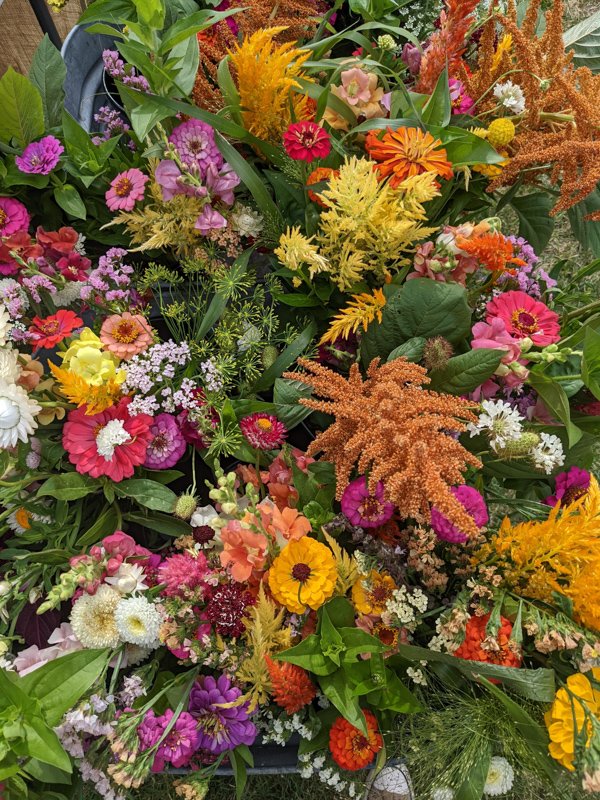Locally Grown Flowers:
An Alternative to What?
Ritual and tradition are funny things: one often imagines various cultural norms to have been carefully designed over many decades and optimized for the most part. But with open eyes we can be caught by surprise to learn that some of these rituals we take for granted don’t make much sense at all. Take our tradition at Valentine’s Day of sending the person or people you love most fresh flowers – sounds so romantic, doesn’t it? Except there are essentially no bouquet-worthy flowers blooming anywhere east of the Sierra Nevada Mountains in the US in January or February. So, in quite literally the depth of the winter, when any vegetation that is alive has slowed growth rates to the barest minimum and day length is the shortest of the year we decide the best way to signal our love and affection is with a highly perishable agricultural product that can only be cultivated thousands of miles from us! Kind of nuts, eh?
Bad Bouquets . . .
The flowers in the bouquet that you buy at a florist or grocery store in the US at nearly anytime of the year most likely originate in Colombia or Ecuador. Because of the lax environmental regulations in these growing countries, and because flowers aren’t classified as food, the amount and variations of pesticides, insecticides, and preservative chemicals is shocking. These chemicals not only stay on the blooms you give to your loved one, but they are doing serious damage to the local ecosystems where the flowers are grown and the people who work and live there. Once harvested, these blooms that have been engineered for travel are flown here on airplanes that are part of the “cold supply chain” of refrigerated planes, trucks, and warehouses – just the transport of Valentine’s Day flowers from Columbia to the US alone incurs a global warming impact estimated to be equivalent to the annual operation of 78,000 automobiles – and this is just a fraction of the global supply chain impact. On top of the negative environmental impact of imported cut flowers, there are many reports of poor working conditions on many of these large-scale cut flower farms that undermines the good feeling we get by giving and receiving a pretty bouquet of flowers.
A Better Bouquet!
Of course, we can do better – and a better bouquet is one with flowers grown locally using up-to-date agricultural techniques (such as organic pest management, minimal soil till, amendments that nurture the soil biome, etc) that close the nutrient circle and benefit not just the humans, but all of the other interconnected living organisms in our environment. You might not be able to give live local flowers as a gift in February, but you can give a subscription for weeks and weeks of fresh flowers to be delivered to you or your loved one. And while having fresh flowers on the table is nice, the surprise and joy of getting flowers is even more special – even if you order them for yourself. A bouquet subscription with fresh, in-season flowers maximizes these moments.
Unlike the flowers grown far away that are shipped dry (because water adds weight, which increases shipping costs), packaged in lots of single-use plastic and other shipping materials, locally grown flowers come to you with a negligible amount of waste. And not only are local flowers less bad, they are also a way better product! Because they are not genetically engineered for transit, they bring with them more vivid colors and stronger smells. We have the flexibility to grow interesting, heirloom varieties of flowers, not just the ones that will ship well.
The flowers grown on most small, local flower farms last longer than imported flowers (often a week or more!), smell better than imported flowers, and the bouquets have a much wider variety of color, shapes, and sizes than you’ll find in imported flowers. Flowers figure so directly into some of our most important rituals such as weddings, graduations, anniversaries, memorial ceremonies that it’s really good news that local flower farms are cropping up to provide these flowers cleanly, sustainably, with the love and care that reflects the celebrations for which they are such an integral part. We are proud to bring this option to the Erie and greater lakeshore communities.
All of these facts provide the eye-opener: our tradition of giving flowers on Valentine’s Day and Mothers’ Day are predicated on several economic externalities: pollution of several types that we don’t have to pay to clean up, and low wages and poor working conditions in poorer countries. The traditions continue because these externalities are not factored into the price, and in the collective ignorance there is little motivation for change.
Locally grown flowers take root in our collective soil, they clean our air, and nurture our insect and bird life. Not only is the circle of these inputs and outputs much smaller geographically than the imported flowers, but the economic circle stays in Erie County, too. These flowers bring the joy of nature and Her beauty to your home, but they bring joy to our home – the joy of making something desirable, of doing hard work together, and of financial security. When you buy our flowers, you lift up your neighbors – the love invested in local flowers flows in many directions.
Not only do you deserve a better bouquet, but all of the living beings impacted by the global cut-flower business deserve a better bouquet. This transformation starts with local flower farms dedicated to supporting the rituals and traditions surrounding flowers – truly Nature’s Love Letter – for you and your loved ones.








